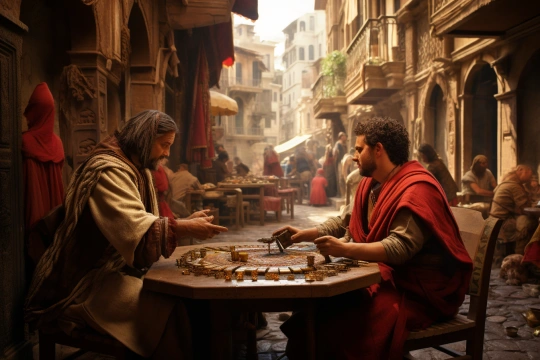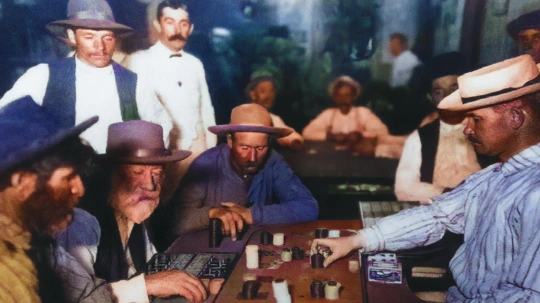In the realm of Ancient Rome, where gladiator battles and extensive military campaigns were an everyday occurrence, there were also other, no less enthralling forms of entertainment. One such amusement was a game known as Tabula. This was a game of chance where two contestants vied to move their pieces to the finish line first, all determined by dice rolls. The game was an integral part of Roman culture, found in the palaces of wealthy patricians, the homes of ordinary citizens, and even in military camps, where soldiers played Tabula to pass time between conflicts.
Tabula was more than just a game, it served as a medium for social interaction, a method of entertainment, and perhaps, a form of education. Its rules were simple and comprehensible, yet they allowed players sufficient space for strategy and tactics. This made Tabula appealing to both casual players and those who aimed for mastery.
The History of the Game Tabula

Tabula, a gambling game sometimes referred to as "Roman backgammon," has deep-rooted history in Ancient Rome. This game, it is believed, developed from older games popular in the Eastern Mediterranean region. It is well-known that the Romans had a fondness for gambling games, and Tabula was no exception.
The game's origins date back to deep antiquity, and the precise time of its emergence is difficult to pinpoint. However, we know that by the 1st century AD, Tabula was widely popular among the Romans. It is mentioned in literary sources, and archaeological findings confirm its popularity.
Tabula was a game of chance accessible to all social classes. Rich and poor, men and women, young and old - everyone played Tabula. The game was played on a special board, akin to a modern backgammon board, and dice were used to dictate the game's progression.
Over the course of time, the rules of the game may have slightly altered, but its essence remained the same. Tabula remained a game of luck, where strategy played a significant role, and each move could determine the outcome of the game. This added a special thrill to the game, making it incredibly popular among the Romans.
Facts about the Game
A Predecessor of Backgammon: Believe it or not, many historians believe that Tabula is indeed ancient Roman backgammon. The elements of both games are strikingly similar, including the use of a board, pieces, and dice. However, unlike backgammon, Tabula was typically played with three dice, not two.
A Universal Love: Tabula was not merely a game for the elite. It was popular among all strata of Ancient Roman society. This was an exceptionally rare occurrence in a society that was strictly divided along class lines.
Serious Business: Despite being a game of chance, serious bets were placed in Tabula. Some players were willing to risk large sums of money, and sometimes even their possessions, for the sake of winning.
Gambling Legislation: Interestingly, there were laws against gambling games in Ancient Rome at the time. However, during the Saturnalia (a Roman holiday), these laws were suspended, and everyone was free to play Tabula.
Tabula in Literature: Tabula is mentioned in the works of many famous Roman authors, including Ovid and Martial. This testifies to how important the game was as a part of Ancient Roman culture.
These facts only underline how integral Tabula was to Roman society. So, the next time you sit down for a game of backgammon, remember its ancient roots and enjoy a game that has enthralled generations.
Rules and Strategies: How to Play Tabula
Prepare to dive into the world of ancient Roman gambling. You are in for thrilling moments requiring strategic thinking and a bit of luck. Here are some basic rules and strategies to help you immerse yourself in the game of Tabula.
Rules of the Game Tabula
Board and Pieces: The Tabula board is divided into two parts, each containing twelve narrow triangles called "points". Each player starts the game with fifteen pieces, placed on specific points on the board.
Moves: Moves are determined by the roll of three dice. Players move their pieces according to the numbers on the dice, moving around the board in opposite directions.
Blocking and Taking: If two or more pieces of one player are located on a board point, that point is blocked for the opponent's pieces. However, if only one piece (called a "blot") is on a point, it can be "taken" by the opponent. The "taken" piece must start its movement from the beginning.
Ending the Game: The goal of the game is to be the first to move all pieces across the board into the "home" and then "bear off" them from the board. The first player to bear off all their pieces is declared the winner.
Strategies of the Game Tabula
Blocking: One of the key strategies in Tabula is blocking points to prevent the opponent's movement. Try to create a "barrier" of two or more pieces to block the board.
Safety: Try to avoid leaving a single piece on a point as it can be easily "taken" by the opponent. Two or more pieces on a point provide safety.
Distribution of Pieces: Even distribution of pieces across the board is usually a good strategy as it provides more opportunities for moves and makes it harder for the opponent to block your play.
Remember, despite all the strategies and tactics, Tabula remains a game where luck plays a significant role. So, whether you win or lose, the main thing is to enjoy the game and the fun it brings. After all, that's the essence of gambling games from ancient times to the present day!
Tabula in the Context of Ancient Roman Culture: More Than Just a Game
The board game Tabula was more than just a pastime in Ancient Rome. It was a method of social interaction, a form of entertainment, a source of excitement, and certainly a cultural element. The game not only reflected social norms and values but also influenced them.
Social and Cultural Impact
Tabula was a popular game among all strata of society - from common citizens to the upper class. The game was found everywhere - from taverns and street stalls to wealthy Roman villas. This game had the unique ability to unite people of different classes and statuses, making it an integral part of Roman society.
It's also worth noting that Tabula was not just recreation, but an important element in Roman mythology and literature. It was frequently mentioned in the works of ancient Roman writers, indicating its significance in the cultural context.
Role in Mythology and Literature
In Roman mythology, it is mentioned that two gods, Mercury and Fortuna, played Tabula, making it part of the divine world. This could have lent the game a special aura and made it even more appealing to the Romans.
In Ancient Rome's literature, the Tabula game is often cited as a symbol of luck and chance. This reflects the importance of concepts of luck and risk in Roman culture and underscores the game's gambling nature.
Overall, Tabula was not just a game but an important part of Roman culture and society. It reflected the social and cultural values of that time and also influenced them. Undoubtedly, understanding this game helps us better comprehend Ancient Rome and its culture.
Tabula Today: A Temporal Bridge to the Past
Let's look at the modern world and see how Tabula is perceived and played today. Undoubtedly, the game has changed over time, but its roots go back to ancient times, and it remains a living testament to history and culture.
Modern Variations of the Game
Modern board games, like backgammon, have a lot in common with Tabula, indicating its influence on the gaming world. Backgammon, like Tabula, uses two game pieces that are moved around the board according to the roll of dice. Blocking and taking pieces are also key elements of both games.
Where and How to Play Today
Today, playing Tabula is possible not only on a physical board but in the virtual space as well. Internet platforms and mobile apps offer game variants, making Tabula accessible to board game enthusiasts worldwide. Additionally, some historical and cultural museums organize events where visitors can learn to play Tabula and understand its historical significance.
Conclusion: Journey into the World of Tabula
Tabula is not just an ancient Roman board game. It's a historical legacy that continues to live today. Studying and playing Tabula is a journey into the past, an opportunity to learn more about ancient Roman culture and society.
Modern variations of the game, like backgammon, underscore the significance and influence of Tabula on the world of board games. And, whether you're playing it on a traditional wooden board or on your smartphone screen, you're part of a continuing story that began thousands of years ago in Ancient Rome.





